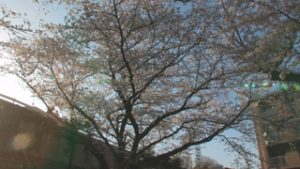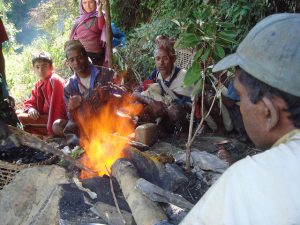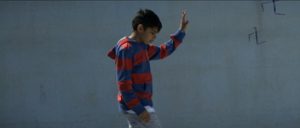『桜の樹の下 Under the Cherry Tree』

「もう死にたい。生きていても仕方がない。早くお迎えに来て欲しい」
私が高齢者福祉の仕事をしていた十年余りの間に、もっとも耳にした言葉だ。そして決して慣れることのできない言葉でもあった。
死にたいという高齢者の訴えを「かまって欲しいだけ」と受け取る人もいるが、そうではない。彼らの生きた時代は激動だった。がむしゃらになって日本という国を作ってきた。そんな自分が老いて弱者となっていることがやりきれない。意味を見出せず死を待つだけの日々が耐え難い。
「生きていても仕方がない」の裏には、「自分だって捨てたもんじゃない、そう感じたいんだよ」という囁きが隠れている。
『桜の樹の下』というドキュメンタリー映画を撮った20代後半の監督:田中圭さんは、高齢者の深いところから漏れてくる声を聞き取ったのだと思う。
神奈川県川崎市の野川西団地。田中監督はその市営住宅に、他の団地とは違うものを感じた。彼女は自分が惹かれたものの正体を「旺盛な生のエネルギー」と書いている。そして市営住宅に住む4名の高齢者の日常にカメラを持ち込み、生活だけでなく、彼らの思い、人生に触れてゆく。
「自然に生まれた映画」と感じるほどに、田中さんは高齢者に程よく寄り添い、彼らに遺された短い時間の傍らで過ごし、同じ景色を観ている。被写体と相対しながらも、静かに彼らと空間を共有している。その距離感が心地よい。
「高度経済成長に伴って発展した川崎という地域性と、その落とし子ともいうべき市営住宅の現状に、日本が抱える高齢者問題を重ね……」と映画の概略を説明することは簡単だが、それはこの作品の主軸ではない。「高齢者問題はもっと多面的な深刻さを包含し、孤独死への恐怖も自死へと繋がるほど切実なのだ」と言うこともできるだろうが、田中さん自身、高齢者と直に関わる中で状況は充分に理解していると思われる。その上で世の中に出回る情報に流されていない。糊塗もしていない。
4名のうちの一人が、その市営住宅を「巣箱」と表しているのが印象的だ。そこは彼らの故郷ではなく、終の住処として選んだ場所でもなく、他に行く宛もない。自分たちは縦横に並んだ巣箱からチョコチョコと出入りをするだけの鳥だ、とでも言いたげであった。
田中さんは「巣箱の中へ監督として入ってゆくが、同じ地域の住人として手を差し伸べているような優しさが、被写体との会話や映像から溢れている。高齢者たちが嬉しそうに、また誇らしげにカメラの前で話す表情には、自分を見てくれる喜び、自分を語れる満足感がある。撮影が進むに連れて、本人たちさえ忘れかけていた自分という存在を、徐々に取り戻していくかのようだ。
それは福祉職として携わっていた自分には難しいことだった。生活を改善する支援はできても、人の存在を変える支援など意図的にできるものではない。
ドキュメンタリー映画とは何かを記録する自己表現だ、と思い込んでいた私にとって、撮られることで自分を表現した4名の姿は新鮮であり、「お年寄り」とは思えないほど初々しく感じられた。
見終わった時、映画にはない場面が浮かんできた。桜の樹の下に登場人物がバラバラに立ち笑っているのだ。「ありがとね……」。声にならない言葉は監督への感謝なのだろう。彼らの人生のラストステージは、この1本の映画によって確かに変わったのである。(佐藤聖子)
The Land Is Mined
An inquiry into the forgotten practice of copper mining

One does not watch The Copper Village, a look into the traditional and laborious process of copper mining and smelting in the mountain village of Okharbot in Western Nepal, without being reminded of recent films produced under the Sensory Ethnography Laboratory (SEL), whose works combine the patience and keen eye of anthropological research with a strong sense of the aesthetics of cinema. One of their recent works, Stephanie Spray and Pacho Velez’s Manakamana, was also shot in Nepal. It documented various groups of people traveling to an ancient temple via a cable car — a journey covered each time in a single shot. Despite the film’s languorous pace at two hours, the world inside the cable car becomes animated by the conversations of the passengers, local and foreign alike (with some animals), emerging from the dark conveyor and released into the vast expanse of the mountains. Focusing more on the journey than the destination, it presents a facet of a cultural tourism that does not rely on plain exoticism.
Filmmakers Dipesh Kharel and Frode Storaas also take us on a journey in The Copper Village by following Ujir, one of the village’s elders and a pioneer foreman, relying on him as a veritable source of information on the process of mining and smelting copper, a traditional practice that is on the brink of extinction in the face of globalization. Copper mining is not only of economic importance to the villagers; it is also an important cultural heritage, as is emphasized by the elders’ laments over the present generation’s inability to pass on this tradition.
In the open forum that followed the screening of the film, Kharel noted that his documentary is like a recreation and rediscovering of the process, “making it known” once again. Thus, he and Storaas take the time to bring us into the dark depths of the mines to obtain the copper ore for the tedious process of smelting. Kharel and Storaas expand their scope by covering the other elements of the process from the making of a bellows (from goat’s skin) and the production of charcoal to the construction of the coal-fired oven, in itself a work of skillful masonry. The filmmakers also introduce us to the various “actors” that take part in the entire process, a kind of reflection of the old caste system. The film, after all, is a celebration of hard work that culminates in the final extraction of the prized copper, which is not even bigger than Ujir’s hand; but their lack of a weighing scale to accurately measure its monetary worth does not diminish its value.
However, The Copper Village is more informational than cinematic, owing its orientation mainly to the directors’ anthropological discipline. The camerawork, with its constant zooming in and out and panning movements during the villagers’ conversations and the steps of the process, is a visual metaphor of the researcher’s eyes and ears; it exudes the inquisitiveness and comprehensiveness of research work, not wanting to miss any aspect of the subject matter. Kharel and Storaas function more as researchers in the film than directors, employing very little variation in the film’s visual design and editing structure, although such variation could have added a certain tension and immediacy to the subject matter.
Jay Rosas
《絶望を走り抜ける―『トトと二人の姉』》

絶望を生き抜くためには、二つ方法がある。ひとつは、自分を失い我を忘れること。そしてもうひとつは、絶望に気付いていないふりをすることである。再出発をするの、ドラッグはもう辞める、と言いながら17歳の姉が家を隅々まで掃除しているシーンから始まるこの映画は、始まるとすぐに、彼女の言葉が、かつて彼女によって既に言われ尽くされたセリフに過ぎないと私たちは思い知らされる。
母は薬物売買で服役中、父はいないため、保護者が不在となった家は不良たちのたまり場となり不潔な環境のなかドラッグが蔓延している。ルーマニアの郊外らしきスラム街の団地を舞台としたこの映画ではしじゅう不穏な空気が漂っており、気でも狂ってしまいそうな生活において、取り残された17歳と15歳の姉、そして10歳の男の子は、毎日を生きている。彼らはまるで繊細でいることを一瞬たりとも許されない、図太くならなければここを生き抜くことが不可能であることの証明のように、自分を守りながら生きていく術を身につける。10歳の男の子トトは何も知らない、或いは知らないふりをすることで自分を守っている。17歳の長女アナは、自らを失うための重要な作業であるかのように、薬物を日常的に摂取している。そして15歳の次女アンドレアは、この劇中で唯一の考える人として存在する。なぜなら彼女は、知らないふりを決め込めるほど若くはなく、なおかつ自らを完全に失うには、あまりにも若すぎるからだ。彼女はなんとか家族の、自分自身の、人生をきちんと立て直そうとひとりぼっちで悩んでいる。
極端なローアングルで撮影されたカメラワーク、そして15歳の少女アンドレア自身がビデオカメラを持って周りに映像を向けたものが時おり挿入されることによって、映画は私たち観客の身体にぴたりと寄り添う。知らない人、或いは知らないふりをしている存在として劇中に登場するトトと同じ目線のカメラは、その場所で起きている痛みと悲しみが、彼の目線を通して、まだ何も知らされていない観客である私たちの身体に憑依する。
悩むということ、絶望から立ち直ろうと努力する行為はとてつもなくしんどいし、傷つく行為だ。これからやってくるだろう、或いはやってこないだろう人生について考えながら泣いている15歳のアンドレアに向かって、児童クラブの職員は励ましながら語りかける。「自分を憐れんでいるの?クヨクヨしないで、人生は戦いよ」こんな言葉を発することができる人間は、真の絶望を知らない人だけだ。人によって、痛みと、絶望の感じ方は違うというのに。しかし、アンドレアは自分が狂うことの誘惑に負けず、なんとか立ち止まる。そして彼女自らがカメラを持ち、孤児院にいる他の子供たちの境遇を聞いてみたり、10歳のトトと一緒になって無邪気にケラケラと遊び回ってみせるのだ。その人間の底力的な強さと、繊細さに耐えうる心が存在するという事実に、私たちは圧倒的に胸を打たれずにはいられない。この世には、絶望をしたことがある人間ならわかることがある。そして絶望をしたことがない人間には、完全に理解のできないことが存在しているのだ。これは、絶望とともに過去を過ごさなければ生きてこられなかった側の味方に位置する映画なのである。(石原海)
![ドキュ山ライブ! [DOCU-YAMA LIVE!]](http://www.yidff-live.info/wp-content/themes/yidff-live_2017/images/header_sp_logo1.png)



